Sheri's HOT Rockets Mercury Redstone
Sheri's Hot Rockets - Mercury Redstone {Kit}
Contributed by John Lee
| Construction Rating: | starstarstarstarstar_border |
| Flight Rating: | starstarstarstarstar_border |
| Overall Rating: | starstarstarstarstar_border |
| Diameter: | 3.00 inches |
| Manufacturer: | Sheri's Hot Rockets  |
| Style: | Scale |

Brief:
Scale, Midpower, Parachute Recovery
Sheri's Mercury Redstone is an impressive looking rocket on her website. It's also fairly impressive when the box shows up on the doorstep. After delaying for a while, I decided to get this one started.
Construction:
The first step in construction is to read through the instructions. They are long, but easy to read and doing so helps one understand steps that will upcoming.
The first real "construction" thing to do is to fish out the two plywood centering rings and a 3/4" square of plywood. The plywood was epoxied onto one of the rings in order to strengthen it for the mounting of an eye bolt for the recovery harness. I used 15 minute epoxy here because I grabbed the wrong bottles.
When the epoxy was set up, I was instructed to drill a hole through the center of the block and through the ring to which it was mounted to receive the bolt. A 1/4" hole was drilled.
The hole being drilled, it was a simple matter to insert the receiver for the bolt and epoxy it into place. It's teeth were forced into the plywood with a pair of pliers. I mixed some five-minute epoxy and prepared to seat the bolt. Unfortunately, I did not pay enough attention and mounted the receiver on the wrong side. By the time I had discovered what I had done, it was too late and the epoxy had set.
The centering ring without the bolt was mounted in the body tube flush with one end. It was mounted with five-minute epoxy and a fillet was applied around the perimeter.
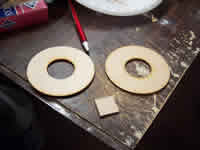
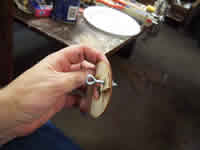

The other centering ring, the one with the bolt, was mounted in the body tube six inches from the forward end. It too was mounted and filleted with five-minute epoxy and it was ensured that the ring of the bolt was facing forward.
The kit came with four plywood fins and a styrene fin template along with a sheet of styrene from which to cut...fins! As it happens, the plywood is just for the core of some built up fins.
The fin template was used to transfer the outline of the fins to the sheet styrene for eight instances. The instruction recommended to use the template as a guide to score the styrene with a razor knife and then flex it to make clean breaks. The scoring and flexing idea worked well for me. Using the template as a guide to do this did not work so well. For me, it was much easier to use a steel rule as a guide for the scoring. That kept my poor template in better shape as well.
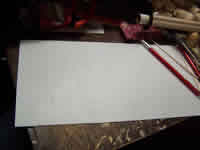
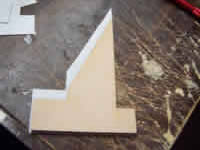
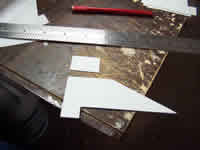
A fact that may be worrisome, for somebody who does not READ the instructions, is that the styrene fins are somewhat larger than the plywood cores. There is a good reason for this. The plywood core is set flush against the base and root edge of the styrene. The styrene is then lightly scored with the razor along the leading edge. The rudders on the outer edge are also scored and then snapped off and saved for later.
The styrene along the angled leading edge of the fins was scored but not snapped off. The scoring was to facilitate bending an angle into the leading edge. After trying several methods of getting this right, the one that worked best for me was to put the plywood core into place and then gently bend the plastic towards the centerline of the fin.
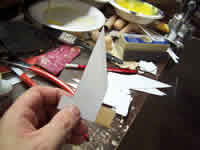

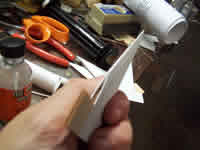
When all of the angles were formed, the styrene was glued to the plywood cores using CA. The resulting bevel actually looked pretty good even if it was not yet "perfect".
At this point, the plywood cores were sandwiched between styrene sheets and bonded with CA. The bevels on the leading edges of the fins still had to be dealt with though. This was easily done with the application of a solvent type of plastic cement. I used Plastruct. This welded the leading edges together and healed all gaps.
The Redstone had another little detail between the fins and the rudders. This kit builds that "thingamabob" out of styrene as well. The template must be cut from the plan that is provided. It is then laid on the styrene to trace the outline four times. I scored the styrene with a razor knife and steel rule. I found this much more difficult that cutting the fins themselves.
The thingamabobs were test fitted onto the fins and it was found that in each case, my cutting left something to be desired. All fit all right towards the bottom, but each had to have the top opened up a bit more. When they all fit, CA was used to cement them to the fin cores. When the CA had dried, solvent cement was used to join the plastic to that of the fins.
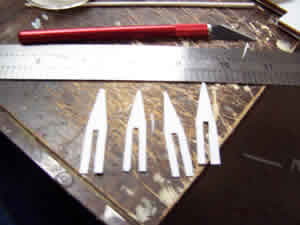
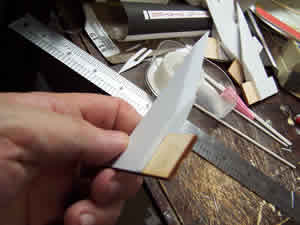
With the thingamabobs in place, the rudders came next. They were formed from the pieces of styrene that were cut from the fins a few steps before and assembled in a similar manner. I held each piece flush against the bottom and inner edges and used the razor knife to score a line. Half were scored on one side and half on the other. The plastic was then gently bent to form the angle using the plywood core as a straightedge.
After bending, the styrene rudder tabs were glued to the plywood cores with CA. When the CA had set, solvent cement was used to join the edges along the angled leading edges and the joint with the thingamabobs. The results were much less than perfect and almost all of the problems were with the thingamabobs. I had not gotten them as well as the other pieces.

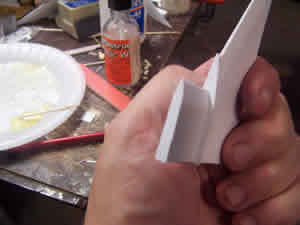
Before capping off the rudders, I needed to clean them up a bit. I used a sanding board to take down the excess material and get the edges of the styrene to line up with the edges of the cores. I then used liquid solvent cement to glue on scraps of styrene to the outer edges, leaving plenty of overhang. When I tried to remove the excess material, though, I found that the joint between the plastic pieces was not handling the abuse. This was rectified by putting a small amount of CA on the tips of the rudder cores and then solvent welding the edges of the plastic.
With the tips re-applied and now holding firm, I trimmed the excess material by first scoring around the perimeter with a razor knife and then using the sanding board to remove smaller humps. There were a few gaps and bulges but I figured that the fairing process would take care of that.
From a distance, the fins looked pretty good, certainly better than most things that come out of my shop, but there were some flaws that bothered me. A few places had gaps between the pieces of styrene. I applied Squadron green putty to the offending area and let the fins cure for a few days.
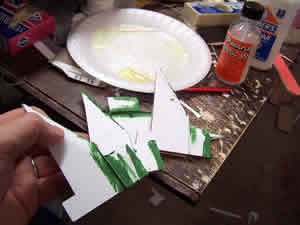
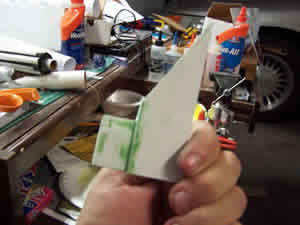
When the few days were up, I went after the accumulated goop with a will using sandpaper, sanding sticks and a little jewelers file to get into those tight corners. A frequent scrubbing of the file with a wire brush was a must as was the brushing away of the dusty by-products. I got it to the point where I thought that painting would make them look "perfect".
The kit comes with a fin marking guide in the form or a wrap around that is cut out of the plan sheet. I cut it out and taped it in place and found that it fit perfectly. The marks for the four fins were transferred to the body tube and the guide was removed. An angle was then used to extend the lines from all the way to the rear to about 8 inches forward. A steel ruler was used to connect opposing lines across the after centering ring.
The instructions then had me offset the fin line by 1/16" to either side to accomodate the width of the fins. I know its a very minor point but I would have preferred to have the correct offset marked on the wrap around guide. This is purely my preference and is the first real thing I would change, but it's so minor that I feel silly even mentioning it. As I said, that would be MY preference.
In any event, the offsets were marked and those lines were extended for the length of the fins. A fresh hobby knife and a steel rule were then used to score along the offset lines so that the vinyl coating could be removed in order to promote better adhesion of the fins.
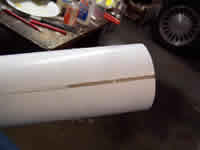
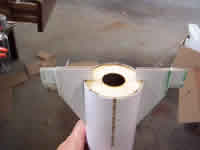
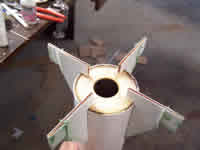
The instruction made no mention of this next step but it is something I now do fairly routinely. I used a drill and made a series of perforations along the fin lines to aid in the formation of epoxy rivets. I did the same thing with a smaller bit along the root edge of the fins.
All four of the fins were mounted using 5 minute epoxy. A small batch was made for one fin and then a toothpick was used to trowel it into place along the BT. It was also used to force epoxy into the rivet holes. After that, it was a simple matter to press the fin into place, check for alignment and hold it in place until the epoxy set up stiff enough to hold on its own. The process was repeated for the other three fins.
I accidentally got the forward centering ring a little too far forward so that the provided motor tube would not extend far enough; when it was inserted, in just bared touched both centering rings without enough overage to provide any support. Fortunately, I had a piece of LOC motor tubing sitting around for a project that has yet to begin and decided to cannibalize it. I inserted it so that the front protruded just a bit from the forward ring and then marked the tube where it had a 1/2" clearance on the aft ring. I then made up a mandrel and cut it to length with a razor knife. The resulting tube was slid into place and secured with more five-minute epoxy.
If there is one thing that surprised me most about this kit it was the instructions on filleting. I expected to fillet the fins with epoxy but the instructions said to used plain old white glue. I decided to follow the instructions to see how it would work out. I began laying in the fillets, letting them dry, rotating the rocket and doing it again.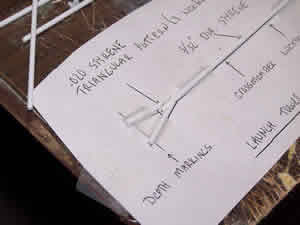
The tower for the launch escape system is built up out of styrene tubing. Construction of the LES begins with taking the plan for one of the verticals and cutting it out to serve as a backdrop and template. The template was taped down securely and then three pieces of 3/16 styrene tubing were cut to length using the template as a guide.
The vertical struts were fabricate one at a time. A piece of the styrene cut to length was taped down on top of the template. Two further pieces of the 3/16 tubing were cut to the length of the "Y" at the bottom of the structure. These were then shaved on one end to achieve the desired angle. When they fit well enough, they too were taped into place on the template and the three pieces were joint with Plastruct solvent cement.
While the solvent was drying, a gusset plate to cover the joint was cut from .020 styrene. It too was then solvent welded into place over the joint. After letting it sit for a few minutes, the structure was taken up, more solvent applied to the opposite side and the entire procedure repeated twice more. I should have mentioned that while the piece was taped down, various depth marks were transferred to the tower struts with a felt tip.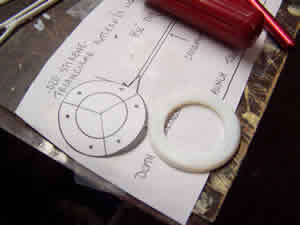
The instructions indicated that the base of the tower was to be fabricated on a plywood ring. I looked in vain for such a piece of plywood. I did find a resin ring but the inner diameter of the ring was different than that shown on the plans. I contacted Sheri and she assured me that it was the correct part and was a result of a design change. Still unsure because of the amount of play left in the 1/8" space between the ring and the capsule, I contacted Sheri again and was reassured that this was correct.
The resin disk has a bevel to it so it must be oriented correctly. I made sure the beveled side was up and then cut out the the template. I taped the template onto the upper surface of the disk and scrounged around until I found a 3/32" drill bit. Six holes were then drilled in the places indicated on the template.
With the six holes drilled, I test fit the vertical struts of the LES tower but did not glue them at this time, even though this was the current step in the instructions. I wanted to make sure about the fit at the other end first.
The upper disk of the LES tower is made of plywood. I cut out its template, taped it into place and drilled the three holes it calls for. The disk was then slid into place at the upper end of the assembly. Since things seemed to fit, both ends were secured with CA.
The horizontal members of the LES trusses are made from 1/16" styrene tubing. Using the plan as a guide for length, I cut the three upper horizontals. I placed them singly at the marks made earlier doing one side at a time and using Plastruct solvent weld. I let on side dry and then brushed the other side with a generous amount and squeezed it into place between the uprights. Since there was a bit of bowing, I used cellophane tape to hold the structure tight as it dried.
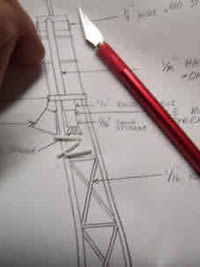
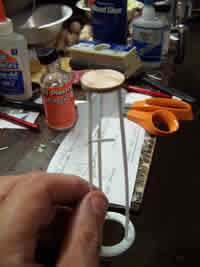
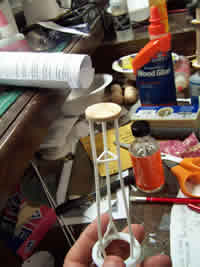
The next day, I peeled off the tape and inspected the results. It was a start.
Since the first one worked out, I got started on the second series of horizontal members. I cut three pieces of tubing from the plan and the solvent welded them into place, using a little tape to hold the joints closed. They too came out fine.
While the solvent welds on the LES tower were hardening up, I got to work on the Triple Mini Motor. It too was fabricated for styrene tubing. Three lengths of 3/4" long by 1/16" tubing were cut to length specified on the plans. A 3/16" piece and a 1/4" piece were also cut. The three pieces of 1/16" tubing were then bundled together and slid inside of the 3/16" piece with 3/16" left protruding. They were fixed into place with solvent weld. Once the three pieces were tacked into place, a razor was used to separate them and bend the three small pieces out at a 30 degree angle. The softening from the Plastruct helped with this. This entire assembly was then slid into the short piece of 1/4" tubing that had been cut and solvent welded. The butt end as gently sanded to keep everything straight.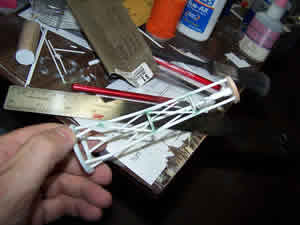
The LES tower being dry by this point, was inverted and set on its cap. The Triple Mini assembly was then glued to the center of the base with CA making sure that the mini nozzles were rotated in such a way as to be centered on the LES truss panels.
I tried cutting the first set of diagonal struts from the plans but that did not work out too well. Each was just a bit too long. Fortunately, Sheri is extremely generous in the materials she packs. I re-cut the diagonals purposefully too long and then started trimming them to fit by a short snip at a time. When they seemed to be the right length, I shaved a bit on one side of the end to give a bit of a miter and then put it in place with tweezers and Plastruct. The lower diagonal struts were placed in the same manner.
I was pretty happy with the way the LES had turned out thus far. It was nothing like perfect but it did represent one of my best efforts to date. It could, however, be improved a bit. This was the point when the truss needed to be faired and the instructions gave the option of Bondo or Squadron Green putty. I had some of the latter and was unfamiliar with the former so I started pressing it into place and let it set up for a day.
The spike at the top of the LES is a built up affair as is most of this kit. The top point was formed by taking a wooden dowel and sanding a point into it. The point was then separated from the rest of the dowel by rolling under a razor knife. The base of the point was then dressed up a bit with some sanding and the point was glued to the end of a styrene tube with CA and set aside.
The "can" at the top of the LES is also built up. The kit comes with a short length of tubing and this was glued to scraps of flat styrene plastic and allowed to set. When it was set up, excess plastic was trimmed away and then sandpaper was used to round the caps even with the edge of the tubing.
A 3/32" hole was drilled in the center of both end caps of the can. The spike was then slid through the top hole and into the bottom hole so that the tubing was flush with the bottom cap. The styrene was then solvent welded into place.
Going back to the LES tower, the Squadron Green goop had hardened and I began the process of sanding it off. At various points I used sandpaper and a file triangular file. The X-acto blade was also a friend.
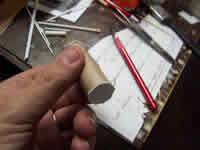
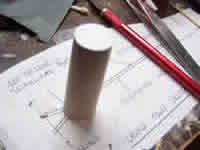
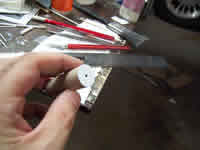
By the time the tower was sanded, the solvent on the can and spike had plenty of time to dry several hundred times over. The next step was to begin applying the bands around the can. These are cut from thin styrene and put into place with CA. The can was laid alongside the plan and the lines were marked. The proper width of styrene was then cut and one end was tacked into place with CA. I wrapped the strip around the can and cut it just a bit longer than needed for a complete circumference. I then whittled and sanded it to length and finished tacking it with CA. I had gotten the wide band and part of the upper skinny band done when I had to leave off to deal with a work issue.
The plans show that the can has a single wide band and two skinny ones. All of the photos, however, show 3 of the skinny ones in addition to the wide one. After considering for a while, I decided that I liked the looks of the three better than the two. So it is that when I got a chance to work on this one again, I finished the unfinished band and then cut another.
The next step is what really caused me some confusion. Both the photos in the instruction and the plans show two pieces of styrene with a half circular profile running vertically on the can, 180 degrees from each other. The text of the instructions makes no mention of them, however. At first I thought this would be fairly simple to take care of. I laid the stock material against the plan and cut two pieces to lengths. Then, because of the plan and the photos, I used sandpaper to put a rounded point at the ends of both of them.
So far so good. My dilemma came when I laid the verticals along the can. My intention all along was to use one of them to hide the seams on the bands. That was fine. The problem was the gaps between the verticals and the can between the bands. The instructions did not say how this was to be achieved.
I fired off a question to Sheri expecting to hear back from her quickly. She had always responded quickly in the past. This time, heard nothing after three days so I sent a follow up and heard nothing. I then remembered that my first message had come during the National Sport Launch and I figured that she might be attending. She may also have decided to take some vacation time afterward. I had to leave town for a week so I decided to wait and see what was waiting for me when I got home. When I did get home, there was nothing.
Although it seemed a forlorn hope, I decided to get to work again on the off chance I could have this rocket ready for my next club launch. I laid a vertical against the can and marked with a pencil where the banding was. I then used a combination of file and razor knife to try and remove material. It was slow and painstaking. I finally got to the point where I realized that it was not going to get any better with MY skills and put the first vertical in place with Plastruct. It looked OK from some directions but there are some big gaps as well. I decided to wait just a bit more before tackling the other one.
Still wanting to work on this one a bit more, I took the cast resin nozzles for the LES out of the bag. Two were connected by way of a sprue and the third was free and slightly lighter shade. That posed no problems at all since they are all meant to be painted. I trimmed off the excess flash with a razor and then sanded them into round.
Being a naturally impatient person, I decided not to wait any longer and to try and place the second vertical tube in the same way as the first. The results were much the same and looked OK from a distance but did not bear close scrutiny. Naturally, I heard from Sheri after I had completed the step.
As it turns out, she was not on vacation but was moving. Having lived through that chaos, I understand the time it took to get back to me. In any event, the recommended procedure was none other than what I had already done except for the quality of craftsmanship. That part is just going to take me some more time until my skills get up there.
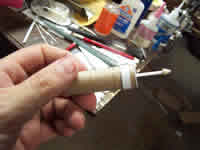
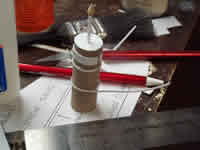
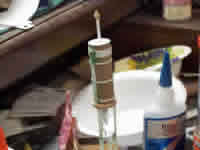
Since I was unhappy with the gaps between the vertical tubes and the can, I used Squadron Green putty to try and fill them. I forced it into the gaps and let it dry for a day. Then the work of sanding it down began. As I feared, this was the difficult part because of my own ineptitude and, probably, because I lacked the proper tools. I'm not even sure what the "proper" tools are. I used a combination approach sanding, carving away with an X-acto and folding the sandpaper into semi-stiff little pieces to get into the tight areas. Eventually, it was as good as it was going to get under my auspices. The green looked hideous to me but I kept reminding myself that it would be hidden by the paint and that it looks better than the gaps.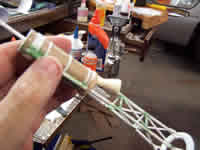
With the can completed, the next step was to affix it to the LES tower. I set it into place and noticed immediately that it was not sitting straight. A close examination revealed that one of my vertical tower struts was just a touch too long. Since it had already been glued to the cap with CA, I could not adjust the cap. I tried to remedy it some what by filing and sanding down the high side of the cap a bit. I probably should have done more but eventually I placed the can with a few drops of thick CA.
At this point I thought I was finished with the LES...but something looked off. Then I noticed the LES nozzles sitting on the desk. Each of these was glued into place with some thick CA. I recommend doing it a few times without the CA and looking at it from several angles to make sure the bevel is straight; then use the CA. And that completed the LES.
Finishing:
The LES tower was primed with 2 coats of Testor's gray primer. That made an immediate difference in the appearance as it made everything uniform and not the sick mixture of green, white and wood product. The instructions on the can said that I had to paint within 2 hours or wait 2 days. Looking the LES over, I did not see where sanding would be an issue so I gave the entire structure 2 coats of Testor's Competition Orange. It was actually starting to look like something good was going to come of this endeavor.
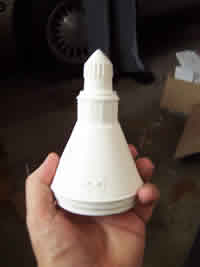
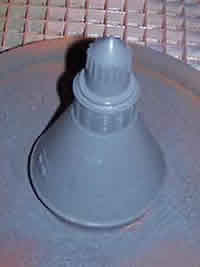
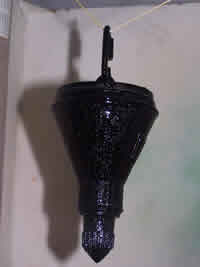
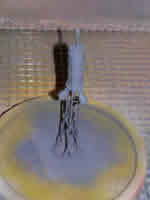
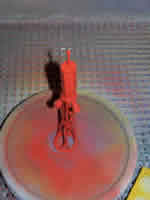
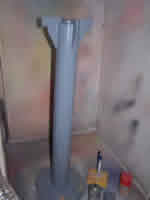
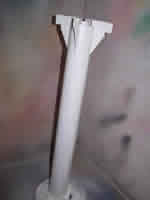
Upon examining the decals and finishing brochure, I decided to go the easy route and make my rocket a "Liberty Bell 7". The finishing guide contains a lot of information on the various Mercury capsules. I am not quite so ambitious as to try to implement it all but it is all appreciated.
I started the decal process on the LES with two simple ones, a large and small version of the Grand Central Rocket Co. data. The larger went on the side of the can and the smaller on one of the nozzles.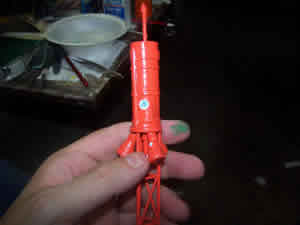
Not long after getting the first two decals in place, I realized that I had skipped a step. I brought out some Tamiya silver acrylic paint and painted the little tubes in the middle of the bottom of the LES as per directions.
The acrylic was given a few minutes to dry and then the rest of the nozzle writing decals were put onto the LES as well as the small GCR logos.
A few days later, I had the chance to apply the large GCR logos to the can. Unlike the text, these were highly visible. One was applied to each side.
The resin capsule needed my attention since it had been languishing. The instructions called for it to be rinsed in a 50-50 solution of bleach and water to get rid of mold release agents. I just used straight clorox and then rinsed it. After it was dried, I set it up in the booth and applied Testor's gray primer. It was about this time I realized that I had forgotten to install the eyescrew so a hole was drilled in the bottom, a bit of epoxy put in place and the screw was tightened into place.
The body of the rocket itself was given a gentle sanding with #400 paper and then brushed off. It was then placed in the booth and primed with Testor's gray.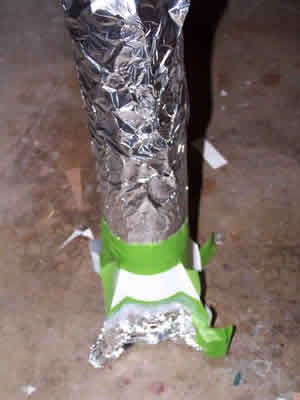
The primer got two days to dry and then it was lightly sanded. The body of the rocket was then painted with two coats of Testor's gloss white. The capsule was likewise sanded and then treated to two coats of Testor's gloss black.
I gave the main body of the rocket a close inspection after the white paint had dried and found some issues. Some of the styrene needed to be tacked down better and I did this with the judicious application of some CA.
I also found some places where the white paint had not completely covered the gray primer. It was back to the booth for more spraying.
The white had almost a week to dry before I began any masking for the black roll pattern. I used a combination of tape and foil to make what I hoped was a fair approximation of the pattern on the instructions. Then it was off to the booth to spray the black. When the masking was peeled off, there were a few places where the black had misted lightly over the white but it was nothing I could not easily fix. It came out better than I had hoped.
I have never been quiet about my preference for decals over stickers. The markings for the capsule on this kit were all waterslides and that was fine by me. The markings for the main body, though, were stickers. They made me rethink my position, at least in terms of vinyl and large projects.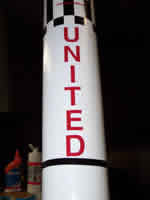
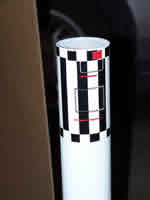
I decided to attempt the large wrap at the top of the body tube first. I used an angle to lightly mark a straight line with a pencil and then peeled the backing. I was also a bit annoyed that the sticker had some paper to peel off of the front as well. I was to learn that this is a GOOD thing. I lined the edge of the sticker up with the line I had marked and with the top of the BT and then gently applied it around the circumference. I was pleased with the way it looked but just a little bit ticked that it did not wrap all the way around. There was a gap of about 1/8" inch that, fortunately, was on the white part of the roll pattern.
Next up was the large lettering for "United" on both sides of the rocket. To my horror, I realized that these were individual letters and not a single sticker and I just KNEW that I would never get the lettering lined up right. I began to transfer tick marks onto the BT with a pencil, knowing I would have to go back and paint or erase them out. I was pretty bummed at this point as I began to peel the front paper off of the letters and had a revelation. The front paper was there for a reason. 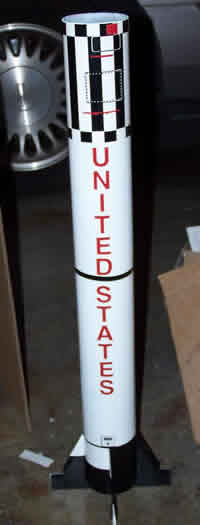
I hoped I was right and smoothed the front paper back down. I then peeled off the back paper, the side with the sticky stuff. The front layer was translucent enough that I could see the lettering. Using the front paper to hold everything in place, I placed the letters and smoothed them down. Then I peeled the front paper off and almost cried for joy that I made this discovery before trying to do things the hard way.
I continued my way down from the "United" lettering. I needed to apply a black band around the circumference. This went on easy enough. It did not close all the way either but the fit was better than the roll pattern and only had about a 1/32" gap. I was able to stretch the vinyl enough to compensate for that.
The "States" lettering came next and it went on as easily as the "United"'s did. I was starting to like this vinyl stuff.
Next was a narrow black band around the top of the fins. I looked and looked and could not find it on the master sheet for the vinyl. I finally remembered seeing it in the box loose. I identified it as automotive pin-striping. This was more than long enough to go around.
The final vinyl was the mission ID. I went with MR 8 and placed the sitckers above each of the fins. I had four left over and do not know whether they are extras or if I just could not find the correct placement.
With that, the main body of the rocket was done and all that was left was the capsule.
The project sat around without any work for a long time because I had ordered a custom chute for it and because I lost the capsule decals. When the chute came in, I decided to make a rush effort to get it ready for a club launch. I had not put on the launch lugs earlier because I wanted to use a linear rail lug. The lug was placed and the screw holes were marked and drilled. A thin layer of epoxy was then put on the bottom of the lug and in the holes and the lug replaced and the screws tightened.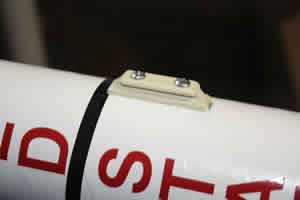
The resin capsule was also a bit tight so I gingerly took it to the belt sander and removed some material around the circumference.
As it turns out, it did not make that launch because I could not find the right motors. That gave me the chance to find the capsule decals and get it done right.
As it happens, though, Sheri read of my losing the decals on TRF. She contacted me and offered to send replacements and did so without any charge. Not too long after, a package showed up at my house and in it were the replacement decals for the capsule along with another decal guide. I want to extend a public thanks for the kindness.
When I got back to work on the Redstone, I noticed the capsule needed some touching up before I applied the decals. It took it back to the booth and sprayed it with black again.
When the paint had about two days to dry, I got started on the final set of decals for the capsule. I began with the "United States" on opposite sides, just to the left of the hatch and window. Next came the US flags centered under the national text. I chose to go with the Liberty Bell mission because I perceived that it would be easier. I don't know how true that really is but its what I did. The mission ID tags were centered under the hatch and window. On one of them, I managed to tear off the "7" and it proved completely irretrievable. The final decal for the capsule was the crack. Mine isn't located exactly where the documentation said; there was not room for it in that position as I understood it. Doubtless, I got something wrong but I'm going more for the "look and feel" than a real scale model.
Throughout the later part of this build, something had bothered me about the LES tower. Most of it looked fine but, when it was set on the capsule, it was jarring. I finally realized what was bothering me when Delta IV posted some photos of his on TRF. My base ring was painted the same bright orange as the rest of the tower. His was black. His looked much better. I got out some black acrylic and brushed the base black.
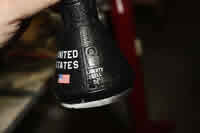
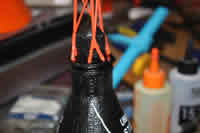
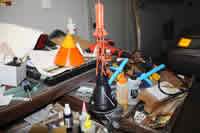
The acrylic dried quickly and, finally, the tower was ready to be mounted on the capsule. A bit of epoxy was put around the to of the capsule and the LES was set in place.
The basis of my shock mount was a length of the extra heavy Kevlar tied to the internal eyebolt. To this was tied a length of heavy braided nylon rope using a double sheet bend. Since I wanted to fly with the LES attached and I worried about it shearing under stress, I decided to try an idea I had read about and chain stitched both the Kevlar and the nylon in an attempt to gentle the deployment a bit. A loop was also tied into the nylon about 2/3 of the way to the capsule to attach the chute harness. One of the things I wanted to avoid during recovery is the LES hitting the ground first. In an attempt to avoid this, I fashioned a harness of nylon fishing line to run back from the tower to the braided nylon so that the capsule would recover horizontally. With that, I thought my Redstone was done and that it would soon take to the air.




I was wrong.
Construction Rating: 4 out of 5
Flight:
After completing the build, the Redstone sat as a hanger queen for a long time due to two unrelated reasons. The first reason was the chute. The kit did not come with a chute. I was aware of this right from the start.
I wanted to order a hemispherical, multi-gore orange and white chute a la NASA. I contacted K&S Rockets and ordered one from there. It came in and was a beauty. It looked really nice. There was only one problem: It would not fit in the rocket. Recall that I had messed up with the motor tube earlier on and the result was less space for the chute. The chute I received also had thick nylon shrouds. I like that for the sake of strength but they took up too much room in conjunction with the chute to fit.
The second reason the rocket sat around for so long is that I had trouble finding a motor for it. Ordering by mail involved extra costs for shipping and all of the local places had no short delays.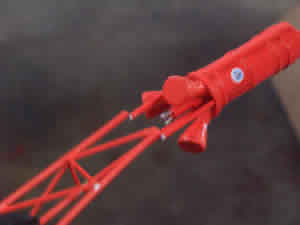
Finally, I learned that another member of my NAR section had the right motor and no use for it. About the same time, I started building a LOC Cyclotron which did come with a chute of the correct size and with much thinner shrouds. I switched the chutes, got ready to fly and tragedy struck. I dropped the capsule on a concrete floor and sheared the tower.
The vertical members were cemented back together with Plastruct and then I started to apply the missing horizontals and diagonals again.
I wept.
One of the things I learned is that resin does not bounce well. Fortunately, the damage to the capsule was minor and a bit of brushed on black paint took care of it.
Finally, the day of reckoning was at hand. I installed a Nomex shied and a LOC parachute and then inserted an Aerotech G77-4R motor. I was thankful that the motor came with a First Fire Jr. igniter and I would not have to mess around with copperheads. I took it out to the rail, set it up and then had to wait while a lot of the LPR traffic cleared out of the way.
Finally my turn came and at the end of the countdown the launch button was pushed. For a while, I thought I had misfire but I noticed something was happening in the motor. Then it roared to life with a lovely red flame and started to move. It looked good coming off the pad but not too far up it angled into the wind and kept climbing. When ejection occurred, I could not tell that the chain stitching made any difference at all but I did have a successful chute deployment. I could also tell right away that the monofilament line used to try to keep the capsule horizontal had not been up to the task. The entire rig spun around on its way down, drifting much more than I expected along the way.
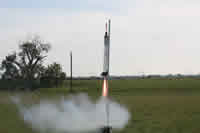
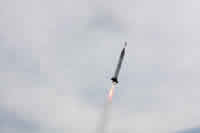
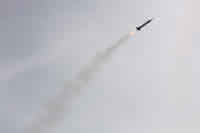
The rocket had a hard landing even though the field was fairly soft. One fin had popped off and the LES was gone. Looking around, one strut of the LES was found. While walking back to the launch area, I had already resolved to rebuild the LES using metal tubing. I was sorry, though that the can portion had been lost. Then a flash of orange caught my eye and I saw the can lying not 20 yards from the pad. The photos show that it was in place during the ascent so my presumption is that the shock of the ejection and chute opening snapped it off and it fell to ground nearby by shear, dumb luck.
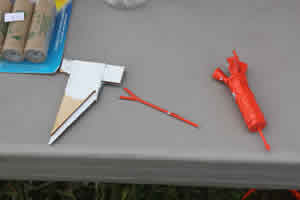
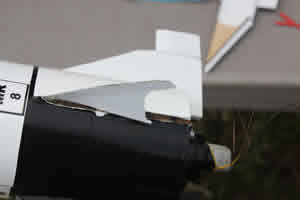
The rocket is repairable but will take some work before it can fly again.
Recovery:
Flight Rating: 4 out of 5
Summary:
While this kit is not for the faint of heart or the inexperienced, it is quite workable and enjoyable to build. I learned much that was new and I pushed my personal envelope with the build. Ffor that I am thankful. It is a heavy kit and I would be reluctant to try flying it with anything less than the G77 but am looking forward to trying it on an H some time.
My big disappointment was with the LES tower. It is fragile and, in all fairness, the instructions mildly suggest that the rocket be flown without it so I cannot say I was not warned. When I rebuild, though, I will try to do it with more durable material that can handle the shock of the chute opening.
Persons interested in following the exploits of this rocket can do so here: http://www.flickr.com/photos/23694991@N03/collections/72157617574666533/
Overall Rating: 4 out of 5
 |
 |
 |
 |
Don Frieders (September 16, 2011)
I enjoyed your review of Sheri's Hot Rockets Mercury Redstone. I just purchesed one from Red Arrow Hobbies at LDRS XXX. Could you check the Flickr link in your article. It appears to be broken. Thanks!